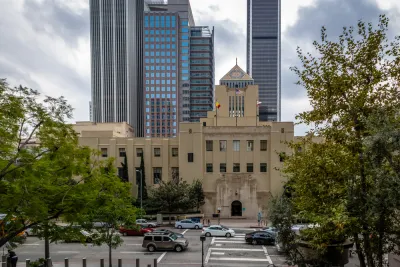The Los Angeles Conservancy turned 40 on March 20. As it marks four decades of preserving historic places throughout L.A. County, the organization considers the next 40 years of preservation in L.A.

In 1978, a small group of concerned citizens formed the Los Angeles Conservancy to create an organized voice for historic preservation across the region. In the wake of major architectural losses including Bunker Hill, the Richfield Building, and Irving Gill's Dodge House—and fighting the demolition of other landmarks including the iconic Central Library—the fledgling Conservancy set out to change the conversation about historic places and how they contribute to a livable city.
The Conservancy marks its 40th on April 5 with a provocative discussion about the future of preservation in L.A. What will historic preservation in Los Angeles look like over the next 40 years? What’s the Conservancy’s role in addressing critical urban issues like density and housing? Who decides what to save?
In advance of the panel discussion, the Conservancy asked the organization's founding president and current chair for their perspectives on how the Conservancy has evolved and the challenges, and opportunities, ahead.
FULL STORY: Forty Years of Leadership

National Parks Layoffs Will Cause Communities to Lose Billions
Thousands of essential park workers were laid off this week, just before the busy spring break season.

Retro-silient?: America’s First “Eco-burb,” The Woodlands Turns 50
A master-planned community north of Houston offers lessons on green infrastructure and resilient design, but falls short of its founder’s lofty affordability and walkability goals.

Delivering for America Plan Will Downgrade Mail Service in at Least 49.5 Percent of Zip Codes
Republican and Democrat lawmakers criticize the plan for its disproportionate negative impact on rural communities.

Test News Post 1
This is a summary

Test News Headline 46
Test for the image on the front page.

Balancing Bombs and Butterflies: How the National Guard Protects a Rare Species
The National Guard at Fort Indiantown Gap uses GIS technology and land management strategies to balance military training with conservation efforts, ensuring the survival of the rare eastern regal fritillary butterfly.
Urban Design for Planners 1: Software Tools
This six-course series explores essential urban design concepts using open source software and equips planners with the tools they need to participate fully in the urban design process.
Planning for Universal Design
Learn the tools for implementing Universal Design in planning regulations.
EMC Planning Group, Inc.
Planetizen
Planetizen
Mpact (formerly Rail~Volution)
Great Falls Development Authority, Inc.
HUDs Office of Policy Development and Research
NYU Wagner Graduate School of Public Service




























